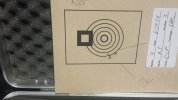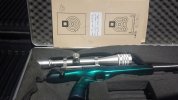Using the Miller stability estimator:
There are many bullets that would stabilize in a slow twist .243 like the 58 & 65 grain V-Max ® provided certain velocities are reached. Many of these short & light weight bullets have plastic tips. The
Berger stability estimator does not make provisions for bullets having plastic tips. I would suggest going to the JBM stability calculator should you desire to use short & light weight 6mm bullets having plastic tips.
Another bullet not having a plastic tip is the 60 6mm Sierra hollow point varminter; I have used these against rodents for years before the advent of plastic tip bullets. Sierra makes a 55 grain plastic tip bullet, the 55 grain Blitz King ®. Running the Miller stability estimator again for the stubby light weight Sierra bullets:
The suggested Sg value needed to ensure stability is 1.4. I have found the Miller stability estimator to be conservative. The JBM estimator makes provisions for plastic tip bullets; plastic tip bullets appear to be your best solution for your 14 twist barrel.
The involved math is simple addition, subtraction, multiplication, division, except for some exponential stuff. A comparison for 30 caliber bullets is used - "=(30*H8)". The math appears on the top line. The JBM stability calculator should provide identical stability estimator values. JBM also has a list of bullet lengths. JBM has some plastic tip lengths but .14 inches is real close.
A comparison of the 70 grain Sierra Blitz King ® with the 55 Sierra Blitz King ®:
Looks like the 70 grain Sierra Blitz King ® is your best choice. The .008 shorter length of the 70 grain Sierra Blitz King ® compared to the longer & more pointy 65 grain V-Max ® allows for slower velocities to get Sg's over 1.39


